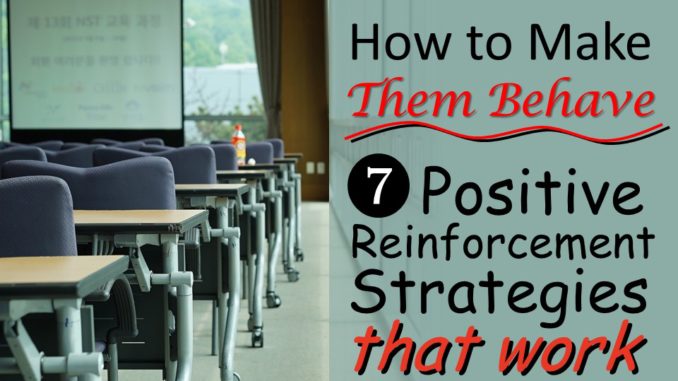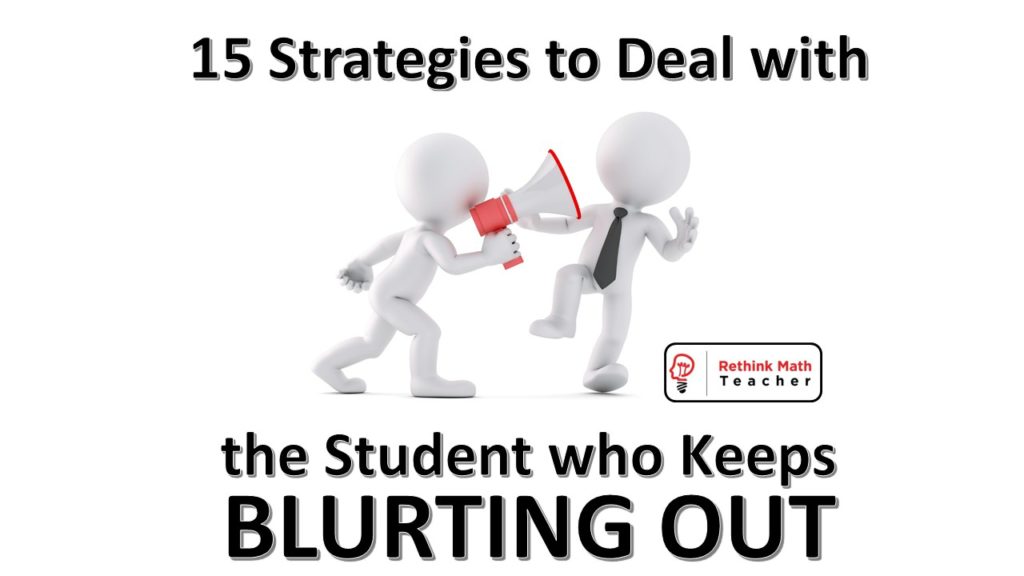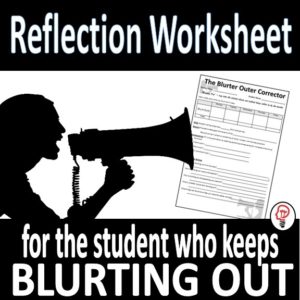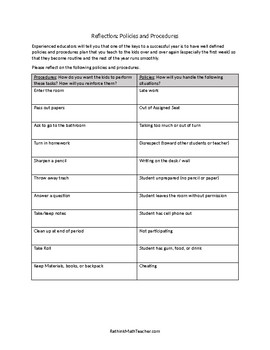
You have no doubt felt the frustration of a class that was difficult to manage. Despite all the discipline in the world, they continue to misbehave and test your patience.
This too was my struggle my first few years of teaching. I had more than one administrator tell me that classroom management was one of my greatest weaknesses.
However, after I realized some effective strategies that changed the way I managed my classes and dealt with my students, I had remarkable success. I was soon given the most difficult classes to teach, because it was no longer a struggle for me. In fact, I enjoyed it. And shortly thereafter, I was made a school administrator.
Here are 7 effective strategies that I used to not only gain control of my classroom, but that also helped me enjoy teaching, even with the difficult classes.
Why My Students Don’t Pass Papers Forward
1) Firmly Establish Procedures and Routines
Whenever I have to coach a teacher at my school who is struggling with classroom management, the first thing we always talk about is ‘Procedures and Routines.’ The students are misbehaving, in part, because the way that they are supposed to do things has not been established, and so they are taking advantage of the situation – or they are not mature enough to handle it.
Either way, your classroom management will be greatly impacted by establishing procedures and routines.
Sit down, and list every possible thing that could happen during the day, and think through how you want your students to perform that task.
How do you want your students to do the following:
- Enter the room
- Turn in homework
- Use the pencil sharpener
- Ask to use the restroom
- Pass out papers
- Clean up
After you have thought about that, teach it to your class, and then model the right and wrong way to do it.
For example, I don’t like my students passing papers forward. Why? Because someone always hits the person in front of them in the head. So I have my class put their papers on the corner of the desk, and I walk around and collect it while they are doing the next activity (this also helps eliminate cheating, stealing, and someone claiming that someone else misplaced their paper).
So after explaining this procedure to this class, I model what that looks like, and what it DOES NOT look like. (The “does not look like” is important. It’s also funny, so the students will remember it). Then we practice it. We actually practice it several times the first day, and several times the next several days, just to make sure we’ve got it.
Yes, I do this with almost ALL of my routines. And yes, it does result in me losing some valuable instructional time at the beginning of the year. But I get all that time back throughout the year by having a well-run class with seamless transitions.
A reflection worksheet for teachers to help them think through their policies and procedures. Click here to preview (this worksheet is free when you purchase the book “Taking Conrol”
2) Improve Student Moral, Attitude, and the Class Environment by Planning this One Thing
I believe in working bell to bell, and accomplishing as much work as possible. However, it’s hard to work all day every day on academics, and sometimes, people need a little break to let their minds reset. Plus, when students enjoy your class, or enjoy you, they will perform better academically and have less incidents. So plan some fun.
Here’s some things I did with my students that they loved.
- We would do math relays, which involved them getting into teams, being outside, competing against each other, and doing different activities (like hula-hooping, carrying an egg on a spoon, or answering a practice test problem).
- Once in a while, I would stop our morning problem, and show a funny video. Here’s my favorite (It’s 5 minutes long, but SO funny).
- Joke of the Day: After our bell-ringer (sometimes called a “do now”) I would tell a ‘joke of the day.’ After several days of this, the students were challenged to do the same, and one student could tell one joke instead of me (I, of course, had to hear it prior to him/her telling it).
- To really spice it up, you can turn it into a girls vs boys competition (or students vs teachers)
- The slow motion turn in: every so often, I would allow the students to turn in their papers to a bin in the front of the room, under the stipulation, that they could only go after I had called their row, and they had to go in slow motion while I played the theme song music from Chariots of Fire. These are some of my favorite moments as students would slow motion run to the front of the room and slow motion dive towards the basket, or crash into another student, pretending to be hit hard, but find the strength to press on. https://www.youtube.com/watch?v=RY3XiM7oGj0
As you can see, these are all just silly things I did to have fun with my students. It didn’t take much time, but it improved morale, helped me have a good relationship with the students, made class enjoyable, and reduced behavioral issues.
There’s nothing like saying to a room full of 8th grade intensive math students, “because you guys are having a hard time entering the room like you’re supposed to…. No Joke of the Day!” (and it truly upsets them).
To be honest, five years from now, I hope that they remember the things I taught them. I hope even more that they remember HOW I taught them to think and respect each other. But I KNOW they will remember these funny things we did… because whenever I see a former student, it’s the first thing that they start talking about.

3) How I use their Competitive Nature to Make them Behave
People are natural competitors. So I love to make things a competition.
For example, I will do a “Manners Matters” competition, where we clearly define a few things that count as good and bad manners for the class. And anytime I catch the class (or a student in the class) displaying good manners, I will give them one point; and negative one point for bad manners (gotta keep it math related!)
Then I will have each class’s score on the white board for the week, and the team with the most points at the end earns some prize. It’s normally nothing big: popcorn and a 15 minute movie, watch a segment of Shark Tank, pack up 2 minutes early for the week, ice-pops, candy… anything that’s not too expensive, or time consuming.
I often let them choose their reward. One class selected an extra week of “Joke of the Day.”
THEY RACED INTO THE ROOM AND QUIETLY SAT DOWN IN UNDER 5 SECONDS
Another favorite competition of mine is the Bellringer Challenge. Class always begins with a “Do Now” also called a “Bellringer” (see #4 below). I start a timer as soon as the bell rings, and stop it when EVERY student has begun working on the bellringer. Then I add the time up for the week for each class, which again, is on the board for all to see.
It is SO effective. My last class that won it was a group of 6th graders who actually came sprinting down the hall on Friday, pencils and paper in hand, because they knew if they got it under 10 seconds they won. It was so funny watching them hush each other as they hurried to their seat and began working. When the bell rang, they all lifted one eye from their paper to make sure that everyone was on task, and then looked at me. I was so excited I cheered for them, and they cheered too! The whole class was rejoicing over being punctual and academic. I loved it!
4) How they start the day, is how they finish the day
It’s easier to keep a student ‘on-task’ than to try to get them ‘back on task.’
So my class starts the minute students enter the room.
I great them at the door with a smile and a handshake, being sure to teach them how to give a good handshake and make good eye contact because I believe this to be a good life skill that will help them one day get a job.
When my students enter the room, there is work on the board, and the expectation is that they walk directly to their assigned seat and begin completing the work on the board.
Now let me be clear, I taught the lowest students in the school, at a Title 1 public school. So I’m not going to a paint a rosy picture that every day these model citizens excitedly walked to their seats and began crunching algebraic formulas. There are always students who “forget” the rules, or really have something important to tell a friend and walk over to their seat. However, I simply call them back to the door, remind them of the expectations, and ask them to try again.
Then, as students are working on the problem(s) on the board, I quietly take role, and do any other administrative duties that need to be done before beginning the lesson.
This method not only sets the proper tone for the period, but makes the most of the minutes we are together, and reduces incidents at the time of the period where they are most likely to occur (entering and leaving the room).

5) How One Jolly Rancher Silenced the Room – Praise, Extra Credit, and Rewards
I once had a teacher come to my room, look at my students as they were entering, and comment that they were her most difficult class. The students were entering the room, a bit talkative, but had made their way to their seats, and most were sitting. I told her, that I would show her how to get them all quiet and on task by only spending a few pennies. She didn’t believe me, especially considering the group of students in the room.
But I walked over to one student who was doing what he was supposed to, and commented “oh, I really like how Billy is working on his Do Now, thank you so much” and I placed a jolly rancher on his desk. Soon other students quickly sat down, and began getting quiet as I walked around the room, looking for other students to reward. I made a few nice comments to other students, and rewarded one or two more. Within one minute, everyone was on task, and quiet.

Click Here to Learn More
Why I Walk Around the Room with a Marker
I don’t always give candy, but one jolly rancher is about ten cents and can be such a powerful motivator.
I do the same thing with a marker. Anyone I catch doing what they’re supposed to, I put +10 on their paper. Ten extra credit points, just for doing what you’re supposed to.
I once had a teacher who would walk around the room with a marker, but instead she would put a zero on their paper because they weren’t doing their work. What message was that communicating to the student? That no matter how hard they tried for the rest of the period, they could not earn a good grade, so why bother? She couldn’t understand why her students didn’t like her and why there were so many discipline issues in her class.
I give extra credit out like it’s water and my students are in the desert.
Sometimes, instead of calling it homework, I call it ‘extra credit.’ It actually has the same impact on their grade (unless, of course, they don’t do it), yet they all want to do it because in their mind ‘extra credit’ is good, and ‘homework’ is bad.
Every once in a while, I will ask the class how much extra credit they would like on the question or activity I am about to give. At the beginning of the year, they usually say 10 points, by the end of the year they’ve figured me out and are saying numbers that more look like Bill Gates’s pay checks.
Finally, I give lots of verbal praise. Most days, I don’t give extra credit or candy, just kind words from the front of the room to people who are on task. It’s very effective, and it doesn’t matter what grade they’re in.
6) The Day that They all Enter the Room Thanking and Hugging Me
One day each year, I would email every parent and tell them that they have a great student and how much I enjoy him/her, with a few other kind words. I would have a blank template, so I could just fill the student’s name in and quickly send it to all the students on the same day. The next day is always the best day of the year. Some kids come in and cry, many thank me, some have funny stories about how their parents hit them when they saw a letter from the teacher… until they read it. I once had a student, tears in his eyes, say he had never received a good note from a teacher – he was 15 years old.
Besides that the students will appreciate you, doing this will also win over the parents.
If you’re first call home is a good one, then, when you have to call the parents for a negative reason, you have already won the parent over, making that conversation so much easier. And the parents will be shocked with their student, “how could you do that to Mr. So-and-So” (because they already think you’re the greatest teacher on the planet).
The Shortest Phone Call You’ll Ever Make
Whenever I tell my teachers to call as many parents as they can the first few weeks of school, they always respond that that would take forever. Clearly, they have never called home to say something nice to a parent.
Positive phone calls home are the easiest, and quickest thing in the world to do. The parents are so stunned, they can barely say thank you, and then you say goodbye. It lasts maybe 20 seconds.

7) Why I Give Makeup Work
It took me a long time to come around to the idea of makeup work for students who had done poorly – or not done the work at all. I felt like I was reinforcing a bad habit, and not teaching them to be accountable.
Then I realized, that I will be evaluated based on my students’ scores on the state diagnostic. And that will come down to them learning the material.
Now I give makeup work and extra credit out like they’re Jolly Ranchers. If doing some makeup work is what gets them to finally comprehend the material, I will give it to them in mad abundance.
Besides the fact that doing this makeup work may help them actually comprehend the material that I am trying to teach them, they also like me for it, and so do their parents. Not that being “liked” is the goal, obviously educating them is the goal – but classroom management and educating them becomes so much easier when you are liked by your students. And the parents will support you when they have good sentiments towards you as well.
Now I will tell you, there are times when I won’t give it, or I will have long talks with them and their parents about responsibility and punctuality. But for the most part, I will give them extra work to help them master the material.
One last thought. Mistakes are part of the learning process. We learn from our mistakes. So I don’t like to penalize students for making mistakes, which is another reason I normally give them an opportunity to make up a grade, provided they are truly learning the material.
Conclusion
Class should be fun. So should you.
When students enjoy their environment, they are more likely to learn. And when they like you, they are more likely to try hard, because they don’t want to disappoint you.
Spend some time today connecting with your students. Have some fun. Enjoy them. I promise the instructional time that you lose, will be gained back because you will have less discipline issues, and harder working students.
3 Bonuses




